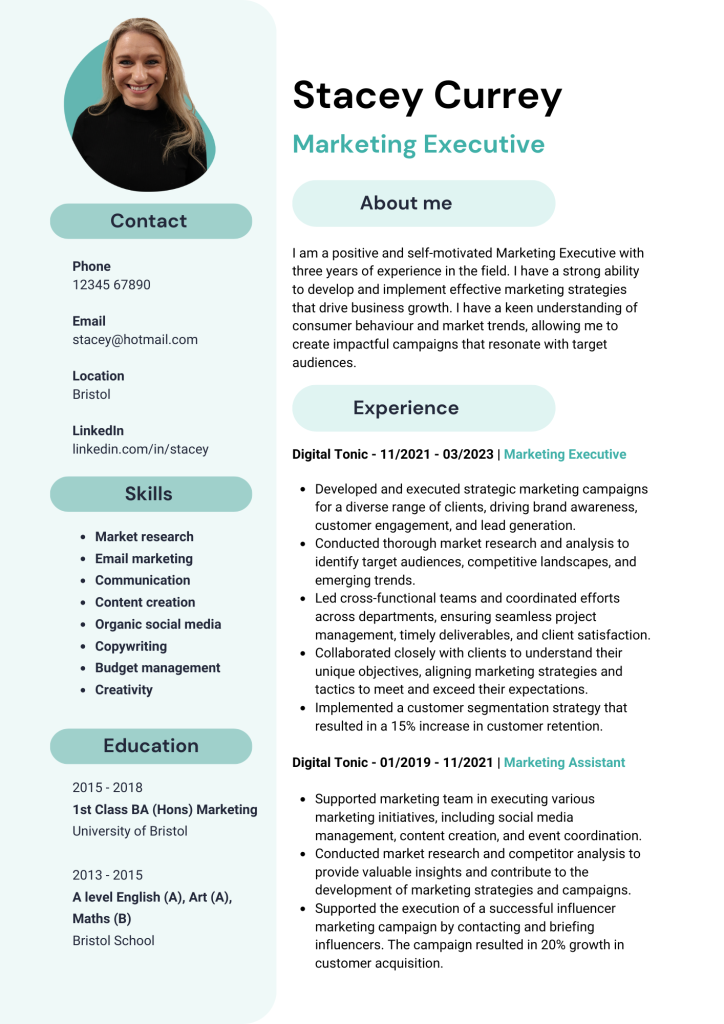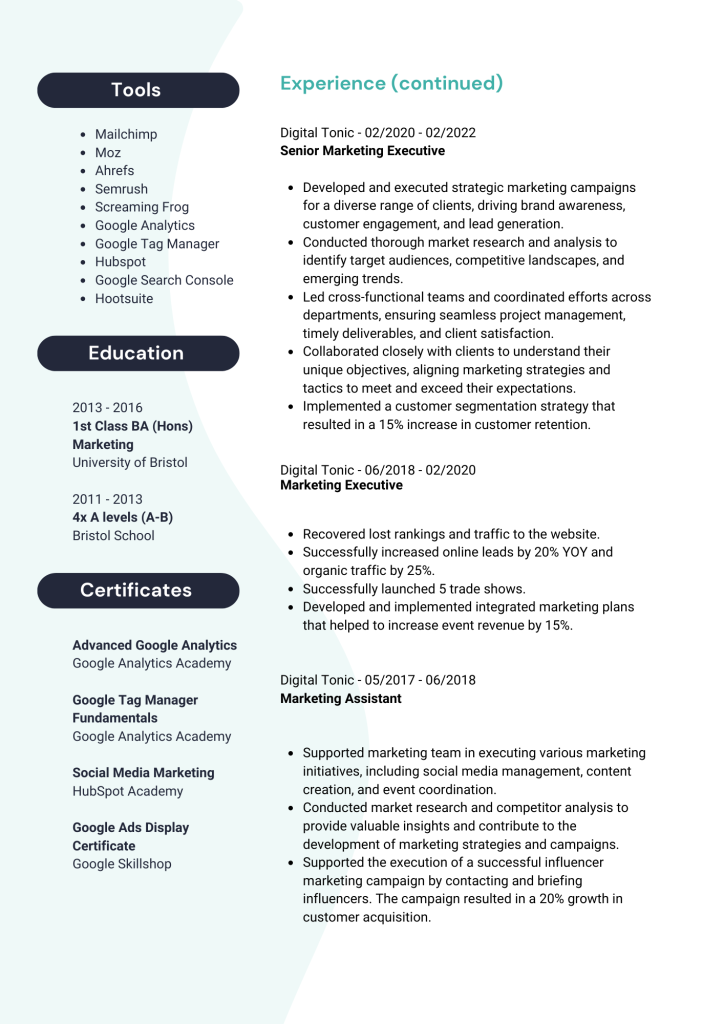Marketing CV Top Tips and Examples
An outstanding marketing CV should be well-written and look polished, regardless of whether you’re starting out in a junior role or are applying for a senior position.
6 Mar 2023

How to write a marketing CV
A knockout marketing CV should showcase examples of your relevant experience, demonstrate your transferrable skills and explain why you’re a match for the role. Components include:
Profile
This is your opportunity to outline what makes you stand out from the crowd, in about 5 lines. What makes you unique and valuable and why should the employer hire you over the next person? Is it your positive attitude or your clever copywriting ability? Or perhaps you have an impressive track record when it comes to driving brand awareness. Use this as your opportunity to shine and show your personality. Remember to include any job-critical certifications here, such as CIM Certifications.
Personal information
Do include:
- Your full name
- Email address
- Phone number
- The city or area you’re based in
Don’t include:
- Your date of birth
- Home address
- Sex / Gender
- Nationality
- Marital status
Trust us when we say that none of the above points belong on your CV. They don’t affect your ability to do the job, so we suggest you leave them out. Plus, lots of employers want to actively avoid discrimination so details on age and gender should never be disclosed.
Now the jury is out on whether to include a photo or not. Ultimately, it’s your decision. But remember, you’re not applying to become Britain’s next top model and including a photo could leave you open to unconscious bias.
Top tip
The email address you include on your CV says more about you than you might think. It should be professional and easy to remember. Avoid using anything silly, funny, or unprofessional that could give a bad impression of you.
Optional information
To make your CV stand out, you might choose to include the below information if it supports your application and is relevant for the role:
- A link to your LinkedIn profile – if you’re including this, you must ensure your profile matches your CV for consistency. Read more about optimising your LinkedIn profile here.
- A link to your portfolio, personal website, or blog.
Work experience
This should be a key focus of your CV, along with the skills section. For each role, include your job title and dates of employment (month and year). Follow this with information on your key responsibilities and achievements. We recommend using bullet points to describe these, rather than writing a chunky wall of text. Aim for around 5 bullet points per role and focus on including things that will be of interest to the hiring manager. Remember to highlight your accomplishments and not just your responsibilities. For example, instead of writing “responsible for growing social media followers” you could create more impact by using a stronger statement like “increased social media followers by 30% in 12 months”.
Key things to consider when it comes to writing your work experience section:
- Use reverse chronological order to show your most recent position at the top.
- Use keywords found in the job specification to show the recruiter that your experience matches the role.
- If you’ve got little work experience, you can include apprenticeships or internships here.
- If it’s not relevant to the role, don’t include it. Don’t include that part-time job you had when you were at school if it’s not relevant.
- Show progression and put your case forward for why you are the perfect candidate for the role.
Top tip
If you’re a junior candidate, you should list education before your work history. But if you’re more experienced, your work history will take precedence over your education and qualifications, so we suggest you list this section above or beside your education. Unless you have very specific education which is essential for the role.
Education and qualifications
This section is crucial for demonstrating your background and knowledge, but you can keep it short in comparison to your work experience and skills sections. Focus on your most relevant and recent qualifications. For example, if you have a degree you should focus on this and provide less detail for your A Levels or GCSEs.
Education and qualifications that employers will be looking for include:
University Degree
Include your type of degree (Bachelor’s, Master’s, or PhD), the subject, dates, your degree classification (First or 1st, 2:1 or 2:i, 2:2 or 2:ii, Third or 3rd), and the name of the awarding University.
Professional Qualification
For example, CIM or IDM. Add details of the type and level of qualification and remember to include dates.
A ‘levels, GCSEs or equivalent
If you have a degree, you don’t necessarily need to focus on your prior qualifications. Instead, you can provide a quick overview. For example, ’3 A levels (A-C)’ or ’10 GCSEs (A-C)’. If A levels or GCSEs are your most recent qualifications, it’s a good idea to provide a little more detail. For example, ‘3 A levels: Art & Design (A), Psychology (B), English (B)’. In cases where you have a lot of higher education, such as a Bachelor’s and a Master’s degree, you can simply leave off your prior qualifications. It’s best to focus on what is most recent and relevant.
Skills
No CV is complete without a skills section to demonstrate your areas of expertise. You should include a mixture of relevant hard skills (job-related competencies) and soft skills (personal traits which are likely to make you a great employee and are transferrable to any role). For example, attention to detail would count as a soft skill and copywriting expertise would class as a hard skill. It’s best to list your skills in bullet points so they can be quickly skimmed by the prospective employer.
If you’re looking for some inspiration on what to include, check out our list of marketing CV skills below.
Hard skills for your marketing CV:
- Copywriting
- Organic social media
- Paid social media
- Technical SEO
- On-page SEO
- PPC
- Email marketing
- Data analysis
- Marketing analytics
- Graphic design
- Email automation
- CMS tools
- Video production
Soft skills for your marketing CV:
- Communication
- Project management
- Adaptability
- Creativity
- Attention to detail
- Leadership
Optional sections
Once you’ve written the key components of your CV, you can consider adding additional sections. These can help build a personal connection with the hiring manager and provide a rounded impression of you as a person. Possible sections to add to your CV include:
Awards and personal achievements
This is a great way to tell your prospective employer more about yourself. It shows that you’re a top candidate who can accomplish top results. Have you run a marathon or received an award? Tell us about it, but only list noteworthy accomplishments in this section.
Hobbies and interests
Depending on the role you’re going for, it might be appropriate to include some key hobbies and interests. Especially if they’re related to the role. For example, are you a skilled photographer or do you spend your free time sketching portraits? These hobbies could demonstrate your creative flair. We’ve got an article all about it here if you’re struggling to decide whether to include them or not.
Certificates
You can include a list of relevant certificates in a separate section if they’ve not already been mentioned. Remember if the certification is job critical, you should highlight it at the top of your CV by your name or in your profile section.
Top tip
Keep optional sections short as they are designed to support the core information in your CV. The focus overall should be on your work experience, skills and qualifications. This shouldn’t be overwhelmed by an extensive list of your hobbies or personal achievements.
Format and design
A simple, easily digestible format is an absolute must for any CV. Our marketing CV format tips are:
Colour
Personally, we love a bit of colour on CVs for creative or marketing roles. It can help draw attention to key content and can demonstrate your creative flair. If you’re using colour, you need to strike that perfect balance of creativity and professionalism. We suggest you swerve using too many whacky colours that could potentially distract the hiring manager from the core information. The important thing is to keep it legible. If you’re applying for a less creative role, don’t feel you must unleash your inner Picasso as it’s not relevant.
Font
Go for a font size of 11-12pt for the body text and pick consistent sizes for your headers, sub-headers and body text. Stick to a simple, easy-to-read font. If you’re updating your CV with new information, remember to check that the font remains the same. We’ve seen plenty of cases where new information has been added in a different font.
Length
The sweet spot is 2 pages for your CV, but this completely depends on your level of experience. Anything between 1-3 pages is acceptable. If you have less experience, stick to 1 page rather than bulking it out to fit across 2. 3 pages is usual for candidates with more experience, but anything more than 3 is a complete no.
Always send your CV as a PDF as this is the best way to perfectly preserve your formatting. Despite what you might have heard, both Word and PDF are easily read by ATS (Applicant Tracking System) software. If you’ve used a program with its own file format like Photoshop, you’ll need to convert it to PDF.
First-person
Always use first-person. Don’t be tempted to use third person, despite what you might have been taught at school. This comes across as very unnatural – in our opinion, it just looks downright odd. Our top tip is to remove pronouns like ‘I’ and ‘my’ to improve readability. This is a method called ‘first-person implied’ and is a great way for detailing your skills and experience. For example, the statement ‘I increased conversion rate by 1%’ should become ‘Increased conversion rate by 1%’. It’s also worth avoiding ‘we’ even when talking about your joint efforts. Focus on your contribution.
Top tip
Save your CV with an easy-to-read file name. Include your first and last name to make it instantly recognisable.
Be innovative
Generally speaking, classic CVs work best. But when it comes to writing a CV for a creative or marketing role, the doors open for innovation. We’ve seen some incredibly creative examples in the past. From CVs with QR codes that link to an online portfolio, to ones which include personalised graphics. If you’re applying for a creative role, use this opportunity to show your eye for design and demonstrate your creative ability. If you do choose an innovative design, we suggest you create a version in a standard template as well, so that you can keep this on hand in case it’s ever required.
Top tips
Be consistent
Check that dates and information are formatted consistently throughout. Remember to check that all of your headings and fonts are formatted consistently too.
Pay attention
Even the tiniest mistake could cast doubt in the hiring manager’s mind about your ability to do the role. Make sure you do a final spell check to ensure spelling and grammar are correct. Otherwise, your CV could end up in the bin.
Use a template
Templates offer a great starting point in terms of layout and guidance on what information to include. There are lots of CV builder tools out there, such as CV Maker UK or Novoresume which can help you build a professional-looking CV in minutes.
Marketing CV examples
Here are some examples to give you an idea of how to format your CV. If your CV doesn’t meet the standard of these examples, it’s time to up your game!
Marketing Executive CV example
Here’s a 1 page example of a Marketing Executive CV. We’ve used the lovely Stacey to bring the example to life a bit – but of course all of the information is just for illustrative purposes.

Marketing Manager CV example
Here’s a 2 page example of a Marketing Manager CV. Again, all of the information is just for illustrative purposes. Hopefully you find it helpful!


If you’re still unsure and want some advice on what to add to your CV, get in touch and the team will be happy to help. And if you’re after some guidance on cover letters, check out our blog on how to write a winning marketing cover letter.
Now that you’ve got some inspiration on how to create a killer CV, it’s time to start looking for your next role.